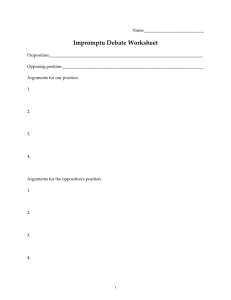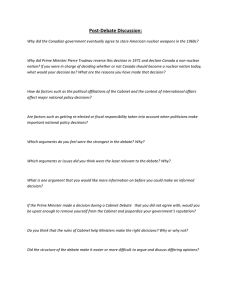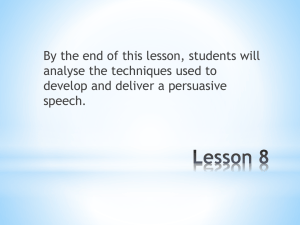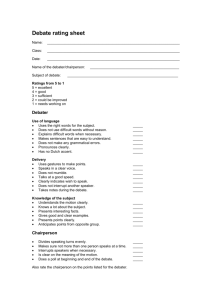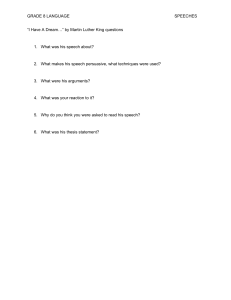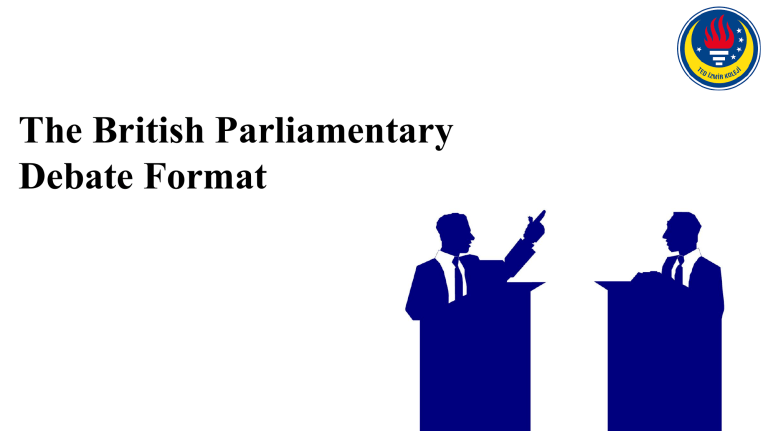
The British Parliamentary Debate Format Depending on your experiences, what should be the rules of a proper debate? What should/shouldn’t be done? Team 1 -> <- Team 3 Team 2 -> <- Team 4 Only one team wins the debate. 1st half -> Teams are randomly assigned before the motion is announced. 2nd half -> A motion is a proposal that is put forward for debate. The proposition (Government) supports the topic given and the opposition is against it. The topic will always request government to argue for a change (argue to change something that currently exists), while opposition will argue against the change. This motion will have the word "believe" in it. «This house believes that the government should not ban animal testing.» Here, the government (proposition) defends a view or belief while the opposition opposes (is against) it. You and a partner receive your topic around 10 minutes before the debate begins. You have 10-15 minutes to prepare your speeches with your pair. You do not get prepared as a group of 4 debaters, you work just with your pair. This is often very nervewracking. So, it is important to remain cool, calm and collected during this time in order to put together the best case possible. You cannot use phones, the internet or smartwatches. You can have papers and pens only. POI (Point of Information) POIs, Points of Information, are questions that anyone on the opposite side of the debater speaking on the podium can raise to the debater. If you want to give your POI, you raise your hand as the debater speaks. The debater might accept your POI and you may ask your question, or s/he might choose not to hear your question by simply saying ‘Thank you’ and you lower your hand and the debater moves on. This form of question cannot last more than 15 seconds. Be careful not to offer them more than 15 seconds as this is called "barracking" and is perceived as extremely rude. In a 7-minute-speech, it’s generally recommended that the debaters accept at least 2 POI requests during their speeches and also offer 2 POIs to all speeches on the side opposite to them. 1st Half The Prime Minister speaks first. They must define every important term in the topic. They must define them carefully. They must define the motion, general arguments, define the meaning of the resolution, etc. Next, the Prime Minister will introduce any points they wish to use to prove the case. It is significant that the Prime Minister sets a clear and narrow resolution so that the debate is focused and not too broad. The prime minister must mention these points very clearly. The time limit is generally 7 minutes for each speaker. The Leader of Opposition should oppose the motion and the case presented by the Prime Minister. They must refute the PM’s case. (prove it incorrect) Be specific. Criticize the case you’ve just heard. Oppose. Why is the motion itself problematic? State your team’s position and provide reasoning to support it. As you prepare for this speech, consider that the motion might possibly do more harm than good, prevent better alternatives, or result in a destructive worldview. The Deputy Prime Minister speaks next. You must refute every point the member of the opposition just introduced, rebuild (re-prove) the Prime Minister's arguments and introduce any additional points you wish to introduce. Be specific. Criticize what you’ve just heard. Compare it to your team’s position. At the very least, add depth to the original case and arguments by providing additional details, examples, or explanation. The Deputy Leader of the Opposition speaks next. Defend your partner’s case from the DPM’s refutation. Reiterate the key elements of your team’s position. Address new, relevant material presented by the Deputy Prime Minister. Illustrate any important tension(s) between the PM & DPM speeches. Add something to your team’s case. You can provide additional examples, explanation, or analysis to support a previous claim. You can present a new argument. 2nd Half - The closing sides now debate. The Member of Government now speaks. You must present an extension to the debate that was done by the opening sides. That is to say, you must open a new side about the issue. You might choose to present an entirely new argument, or you might develop an important argument that the Opening Proposition could not develop. Do not state anything that is against the Opening Proposition. Explain why what you’re adding is important in relation to the arguments given by the Prime Minister and Deputy Prime Minister. Answer the new material presented by the Member of Government and refute them (prove them incorrect). Add something new. You might choose to present a new argument or develop a previous one. (Do not just repeat it.) Do not state anything that is against the Opening Opposition as you support the same opinion. Explain why what you’re adding is important in relation to the arguments given by the Leader of the Opposition and Deputy Leader of the Opposition. Identify the 2-3 most powerful concepts and arguments in the debate. Express why your position defeats the most important arguments presented by the Opposition. Answer the contribution made by the Member of Opposition. Avoid making new arguments. You may, however, add details or examples in support of previous claims. Summarize! (Do not just repeat!) The whip speeches are very important, you should always be thinking about the case as a whole. Identify the 2-3 most relevant concepts in the debate. The previous debater has just done this. Identify different concepts. (Do not just repeat the things mentioned by the Government Whip.) The concepts you identify should then serve as the main points of your speech. Sell your contribution. Explain how your team’s position relates to other important arguments in the debate. Avoid making new arguments. You may, however, add details or examples in support of previous claims. Whip speeches are like a newspaper report; they lay out their arguments in a way that makes it look like your team has won the whole debate. The chair (judge) moderates the debate. The judge take notes about the performances of the debaters. The judge reminds the debaters as they give their speeches that they have ONE minute left. When the time is over, the judge interrupts and ends the speech. As each speech is over, the judge invites the following debater to the podium calling them by their role. «Thank you for your speech Prime Minister. Now we can move on with the speech of the leader of the opposition. Please come to the podium. Your time starts now.» The panelists do not interfere during the speeches. They observe and take notes about the performances so as to decide on the rank together with the judge. After the conclusion of all speeches, the chair asks all participants to leave the room. The chair and panelists (other judges) then spend a few minutes deciding on the rank. Each team is given a ranking (first place, second place, third place, fourth place). Each speaker is assigned a speaker score on a 0-100 scale. When the decision is finalized, the judges invite the debaters back into the room. The decision is announced, and the chair provides some reasoning to support the rankings. Always show respect toward the decision and the judging panel. Which roles do you think are the most and least challenging ones? Why?

